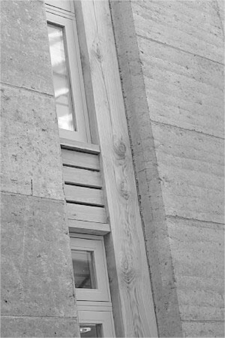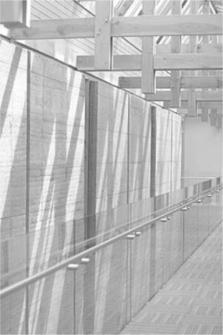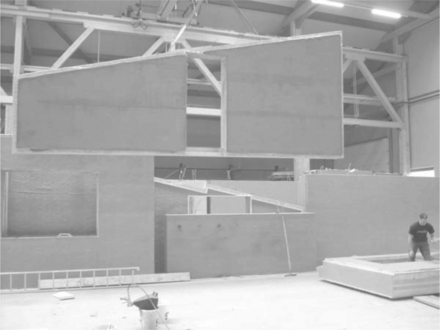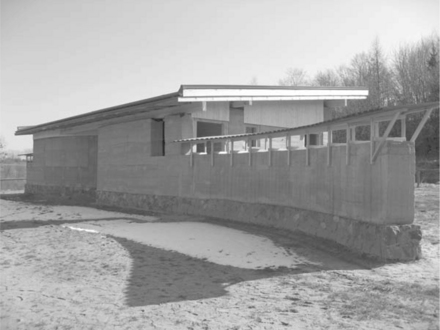European modern earth construction
Abstract:
This chapter presents an overview of modern (post-1970) earth building technology and selected contemporary case studies throughout europe. It includes an appraisal of the conservation and revival of traditional earth building techniques, as well as modern construction techniques that have been adapted for commercialisation and compatibility with the modern day construction industry. Details are included for formwork types, approaches to soil stabilisation, structural detailing and fabric insulation.
23.1 Introduction
Europe has an extensive history of earth construction and a wide variety of techniques. Many of these have, at some point, been exported to other parts of the world. This chapter reviews the current state-of-the-art in modern earth construction within Europe. It summarises the techniques and products currently available for deployment within the construction industry whilst providing further links to useful resources, further reading, organisations and specialist contractors. The chapter also provides highlights of modern earth buildings throughout the continent.
Europe has a history of earth building that dates from Roman times and perhaps earlier. examples exist in many areas and, according to where the building has been located, a wide variety of techniques have been employed (easton, 1996). Traditional names for these techniques vary according to area but recognised names include: adobe, clay dabbin, clay lump, clom, clunch, cob, mud wall, mud and stud, piled earth, puddled clay, rammed earth, rammed chalk, wattle and daub and wytchert. The techniques have developed to suit the locally available materials. The type and proportion of clay in the soil being the most important factor, but perhaps also the proportion of sand and gravel in the soil or locally available materials that can be blended to give the desired soil grading. The types of buildings constructed in earth varied according to where and when they were built. They varied from, commonly, simple walls, barns and farmers’ houses to, occasionally, fine country houses and public buildings. Terra Britannica: A Celebration of Earthen Structures in Great Britain and Ireland (Gourley and Hurd, 2000) gives a good summary of the different techniques that were used historically and the areas where they were used.
23.2 Conservation and revival of traditional techniques
Considerable efforts have been directed towards understanding and conserving heritage earthen buildings and structures. Previous examples include the well-known Project Terra organised by leading experts from the Getty Conservation Institute (USA), International Centre for the Study of the Preservation and Restoration of Cultural Property (ICCROM) (Italy) and Centre International de la Construction en Terre (CRATerre) (France). Academic research into the preservation and restoration of traditional earth buildings has naturally developed into a desire to apply the techniques to new build projects. Within the UK context, the book Earth Building: Methods, Materials, Repair and Conservation (Keefe, 2005) is an excellent technical guide to traditional vernacular earth building (particularly in Devon) techniques and includes detailed references as to how compliance with modern building regulations could be sought. More recently, Alan Stokes produced an advisory document for the Devon Earth Building Association (DEBA) that advises on how proposed new buildings made from traditional mud, cob or other unfired earth buildings would be treated by the Building Regulations for England and Wales. As there are many examples of heritage traditional earth buildings in this county, it is possible to use these to demonstrate structural stability and material behaviour under the local climate, which in some cases can satisfy these aspects of the Building Regulations. However, the lack of such traditions in other regions of the UK may preclude this, and the very poor fabric U-value means that acceptable energy efficiency ratings can only be met by offsetting the high heat energy loss with supplementary renewable energy technologies (Stokes, 2008).
Lately, enthusiasts for environmental building have joined the cause suggesting that traditional earth construction (e.g. cob, adobe) could present a solution for low carbon buildings of the future. Throughout Europe there is a great level of interest, both academically and amongst a small number of dedicated practitioners, in the study and conservation of earthen architecture heritage buildings and structures. This has also inspired several modern builders to attempt to introduce these traditional techniques of earth building and integrate them within modern buildings, as discussed in the following sections.
The CULTURA 2000 European Programme funded a research project entitled ‘Houses and Cities Built with Earth’. The main aim was to give technical training in the conservation of heritage earthen buildings. This included intensive workshops with experts and involved the Università di Cagliari (Italy), ESG/Escola Superior Gallaecia (Portugal) and Universitat de València – Dept Historia (Spain). The project led to the publication of a book entitled Houses and Cities Built with Earth: Conservation, Significance and Urban Quality (Achenga et al, 2006). The ‘Terra Incognita’ project produced a state-of-the-art review of earthen architecture in Italy, France, Spain and Portugal, in terms of its heritage and the associated education, training and research. More recently, this was expanded to include all 27 European Union member state countries in the ‘Terra Incognita II’ project, creating an atlas of regional earth building heritage for Europe and establishing a network of expertise. Details of publications relating to all of these projects are given in Section 2photograph by3.8 ‘Sources of further information’. The Terra Incognita projects also led to a series of awards being given in 2011 for ‘Outstanding Earthen Architecture in Europe’, in which 42 buildings were shortlisted across three separate categories:
Category 1: Buildings with archaeological, historical or architectural interest
Category 2: Buildings subject to remarkable and relevant intervention (restoration, rehabilitation or extension)
Category 3: Buildings constructed after 1970 (i.e. ‘modern’).
23.2.1 Cob
Devon has the largest population of earth buildings out of all the British counties. More than 20,000 houses and an equal number of barns, outbuildings and boundary walls may exist (Rael, 2009). This population provides a steady workload for specialist builders to maintain and repair these old buildings. Kevin McCabe is probably the best known exponent and most prolific cob builder in Britain. He claims to have built or repaired something in cob every year for the last 30 years. Starting by repairing old walls he moved on to building extensions on existing cob houses and, since 1994, he has completed four new-build cob houses. Generally these are traditional in style and have thick walls (600–900 mm), which are often curved as no formwork is used. Foundations are concrete with a stone or concrete block plinth rising about 600 mm above ground level. Windows and doorways are generally small as the cob is heavy and lintels are required due to the low tensile strength of the mud material. As a result of the uneven shape of the walls, all structural and internal woodwork is bespoke for each building. The exterior is rendered with a traditional coarse sand and lime putty mix, followed by several coats of lime wash that require periodic maintenance by recoating. To an admirer of vernacular building these are attractive houses, but are slow to build and require specialist skills. Cob in Cornwall is a small company that was started in 1994 by two enthusiasts after completing a cob building course in America. The company is led by Katie Bryce and Adam Weismann who started by repairing historic cob walls in Cornwall, then progressed to new-build cob houses and have now developed a range of natural clay plasters through the company Clayworks Ltd.
23.2.2 Clay lump/adobe
Clay lump is an English form of adobe, or unfired mud brick construction. It was relatively popular in Norfolk and Suffolk during the 18th century and was probably introduced from abroad. It seems to have suited the local glacial boulder clay, which is malleable but prone to shrinkage. The bricks would be air dried before use, thus avoiding shrinkage in the wall. Up to 20,000 earth buildings are thought to still exist in East Anglia (Rael, 2009), the majority of which were made using this technique. Often the clay lump is hidden behind a layer of render, facing bricks or flint and thus is commonly not recognised. In 1994, East Anglian Rural Telluric Houses Association (EARTHA) was formed to promote the study, maintenance and promotion of the earth buildings in the east of England and is led by Dirk Bouwens. They have studied and repaired many historic earth buildings, organised training courses in clay lump building and endeavoured to create the opportunity for new-build houses. Whilst walls built in clay lump seem to have a good record of structural performance within the existing stock of historic buildings, the thermal performance of these traditional buildings is not compatible with the ever-increasing UK building regulations. The answer being proposed to improve this is to add a layer of insulation and then a layer of weather protective material on the outside of external walls. This is not entirely straightforward because some air circulation will still be needed under the insulation to prevent moisture build up in the wall. Becky Little (Little and Davie Construction, Scotland) constructed an adobe/clay lump visitor centre at Rowardennan alongside Loch Lomond, Scotland. It was constructed using materials that were mainly sourced locally including a peg-jointed oak frame, using trees felled from the surrounding forest. The timber roof is covered with re-used slates and the natural stone plinth walls were laid using lime mortar. The load-bearing external walls were constructed using straw reinforced adobe blocks, which are externally rendered with traditional sand/lime and white lime wash, and internally plastered with clay. Currently Dirk Bouwens and a local builder are seeking planning permission to build nine bungalows in clay lump. If they are successful and the buildings are completed satisfactorily, this will be a landmark project for this traditional technique.
23.3 Modern earth construction techniques
This principally includes traditional (or unstabilised) rammed earth, stabilised rammed earth (SRE), stabilised compressed earth blocks (CEBs) and unfired clay bricks. Sourcing and testing of suitable raw materials is an add-on cost that standard building materials rarely require, and currently presents a problem since there is no mainstream requirement for earth building materials. If earth building is to become more widely accepted within Europe, and used for more mainstream building projects as in Australia and North America, then it is essential they become as compatible with the requirements of construction professionals, contractors and building regulations as other masonry materials. Wooley argues that over-enthusiasm for eco-materials can widen the gap between those seeking to be environmentally friendly and green building policies at government level (Wooley, 2000). Unstabilised rammed earth (with or without the inclusion of sodium silicate surface treatment) is recognised as an A + rated material (highest rating) under the BREEAM Green Guide 2008 (BRE, 2008), which is an internationally recognised system of assessment for building materials. By means of comparison, an A + rating is also achieved under the BREEAM Green Guide using, for example, medium density concrete blockwork with sand/cement mortar plus external surface render and internal gypsum plaster. Since the cement content of concrete blocks (~ 7%wt) is the same as that used in SRE, it is reasonable to assume that SRE would also achieve the same A + rating, especially since it does not include sand/cement mortar joints, external sand/cement render or internal gypsum plaster.
A number of key projects have been built recently in the UK, almost all of which have been constructed using unstabilised rammed earth. The earth building enthusiasts who promoted these projects indicate that the use of Portland cement as a stabiliser, as used by the Americans and Australians, was against their environmental aspirations due to the increase in embodied energy of the wall elements. The soil can sometimes be sourced from the building site, but almost invariably this requires amendment through the addition/ subtraction of imported soils or quarried aggregates to provide the appropriate particle size distribution. A more controlled form of material selection is to obtain overburden from a local quarry, which is often available at very low cost. If the material is to be unstabilised, then the %wt clay and silt (i.e. fines) content needs to be substantially higher than for stabilised material, and hence material selection and testing of the linear shrinkage coefficient is of paramount importance. As an unbound material, unstabilised earth often requires the addition of surface treatments, sealants or a protective screen. The surface of the rammed earth walls at the Eden Project (see Fig. 23.1), for example, are sealed with sodium silicate solution (known as ‘water glass’) as a dust suppressant. The earth walls at the Autonomous Environmental Information Centre (AtEIC), as shown in Fig. 23.2, are covered by protective sheets of transparent plastic to allow visitors to see the walls without being able to touch or damage them. More recently, unstabilised rammed earth walls have been constructed inside a building (either load-bearing or non-load-bearing) and protected from weather by an external façade, such as the WISE lecture theatre, Centre for Alternative Technology (CAT) in Wales (see Section 23.5).

23.1 Unstabilised rammed earth external walls (coated with sodium silicate) at the Eden Project Visitor Centre, Cornwall, UK. (© Paul Jaquin, 2004)
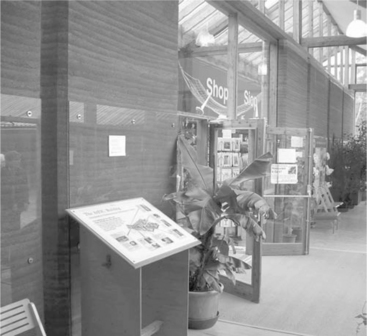
23.2 Unstabilised rammed earth internal wall at the Autonomous Environmental Information Centre (AtEIC), Centre for Alternative Technology (CAT), Wales. (© M R Hall, 2004)
SRE materials typically have 7%wt white Portland cement stabilisation with encapsulated insulation (cavity) and hydrophobic admixtures, which provide capillary water resistance (see Chapter 10) whilst maintaining vapour permeability. The material is almost always sourced as crushed quarry waste or as raised natural ballast, which is ubiquitous and abundant; it can be blended to achieve the desired particle grading at the quarry in batches to suit the size of the project. Due to the lower silt and clay content requirements of stabilised soil mixes, they have low cohesion prior to stabilisation and so can easily be dry mixed to ensure consistency throughout the batch regardless of total quantity required. The exterior surfaces do not need coatings or additional surface treatments as they are a bound material. SRE is highly suitable for being recycled into new buildings or as engineering rock fill (e.g. for road sub-base, which has identical grading), and unlike unstabilised earth materials the raw material can be partially or wholly substituted with crushed masonry and recycled concrete aggregate (RCA) from demolished buildings. This avoids primary aggregate extraction, thus minimising the environmental impact of quarrying, and also the costs associated with the aggregate levy (taxation) charges, which are not applied to alternative (i.e. recycled or by-product) aggregates in the UK. Although the particle grading of alternative aggregates (e.g. RCA) is highly suited to dynamic compaction, they do not contain clay minerals and so require stabilisation using a binder, e.g. Portland cement. The total content of cement required can be significantly reduced depending on the age of the demolished concrete and the amount of unhydrated cement it already contains.
Dynamic compaction is typically achieved using pneumatic tampers powered by an air compressor, typically requiring at least 20 cubic feet per minute air flow rate per tamper. Common makes available in Europe include Atlas Copco, Ingersoll Rand, Jet and others. Some contractors use lightweight, proprietary formwork systems such as Doka Frami™ or Stabilform™, as shown in Fig. 23.3. These modularised systems allow architects and engineers to design wall structures in multiples of 300 mm, which minimises construction costs/waste, and maximises efficiency. The outer panels are 600 mm high and can be assembled in horizontal lengths of, for example, 1200 mm, 1500 mm, and so on. Vertical bracing allows wall heights in excess of 9 m and is accessible by conventional scissor lifts, scaffold systems and plant.
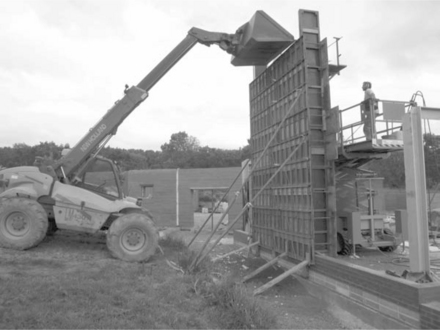
23.3 Stabilform™ in use on a 5.2-m stabilised cavity-insulated rammed earth wall at Honiton, Devon. (© Earth Structures Europe Ltd, 2007)
Other contractors have used similar lightweight systems, such as the one shown in Fig. 23.4 that was used to construct the 6 m unstabilised rammed earth internal wall at the Rivergreen Centre, Aykley Heads. In contrast, another example was the use of the California-style formwork system pioneered by David Easton (see Chapter 15). This allows the formwork to be used as a modularised system, based on standard plywood and stock timber dimensions (e.g. 1200 2400 mm), whilst offering the advantage of being easily customised on-site by carpenters. The timber formwork can be re-used for future projects or it can be recycled and integrated into the building for use in internal partition walls, as was the case for the example shown in Fig. 23.5.
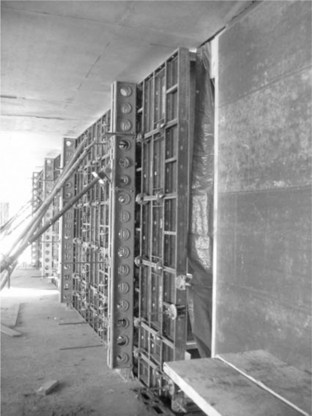
23.4 Lightweight formwork in use during construction of the 6-m unstabilised internal rammed earth wall at the Rivergreen centre, Aykley Heads, near Durham, UK. (© Paul Jaquin, 2005)
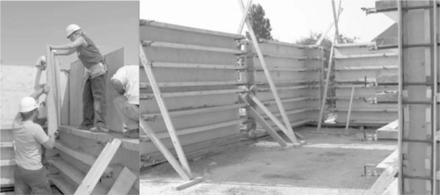
23.5 California-style timber formwork system in use during the construction of a stabilised rammed earth pavilion, Chesterfield, UK. (© M R Hall, 2003)
The base of SRE walls is typically engineering brick or a concrete stem wall integrated with the foundations, either of which can be rated frost-resistant as appropriate. This allows for positioning of the formwork system and also the inclusion of a physical damp-proof layer to prevent capillary rise of salt-laden groundwater, as shown by the example in Fig. 23.6.
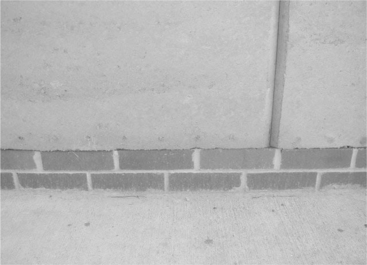
23.6 Engineering brick base course with damp-proof layer, at 150 mm above ground level, and SRE wall at the stables building, The Manor, Ashley, UK. (© M R Hall, 2002)
For small openings (typically < 900 mm) SRE materials can either be self supporting or reinforced with steel bars to increase flexural strength and resistance to cracking. Small openings such as windows can therefore be cast directly into wall sections, which often include a chamfer detail both to increase the amount of light entering the building and to eliminate the potential for accidental damage to the edges (see Fig. 23.7).
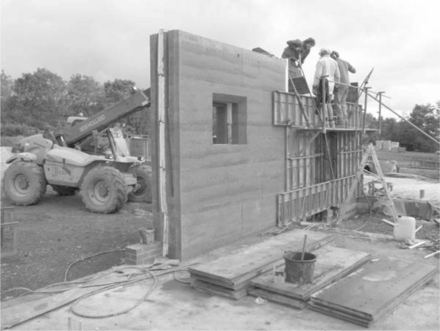
23.7 Stabilised rammed earth wall with extruded polystyrene cavity insulation and small opening with chamfered edge detail and the Stabilform™ formwork system, at Straightways Farm, Devon, UK. (© Earth Structures Europe Ltd, 2007)
Note the two vertical rebates and chamfered edges cast into the edge of the wall section in Fig. 23.7. This enables the adjacent wall section to form a mechanical interlock, whilst just below the chamfer two thin neoprene strips are inserted such that the joint is sealed against air leakage or water penetration but allows thermal expansion/contraction of walls panels, as shown by the example in Fig. 23.8. The exact spacing between vertical expansion joints varies according to the linear expansion coefficient of the material, but is commonly 4 m with up to 6 m possible for lower expansion soils. The thermal expansion of cement SRE is low and equivalent to that of low modulus concrete (of the order 10 s/K). Unstabilised rammed earth typically has a much lower modulus of elasticity, and as an unbound soil is naturally more susceptible to thermal and hygric expansion/contraction, although this can be minimised with correct material selection. Figure 23.9 shows a similar format of expansion joint detailing on the unstabilised rammed earth walls at the Rivergreen Centre, Aykley Heads, UK.

23.8 Close-up of a chamfered thermal expansion joint detail on an SRE wall at the stables, The Manor, Ashley, UK. (© M R Hall, 2002)
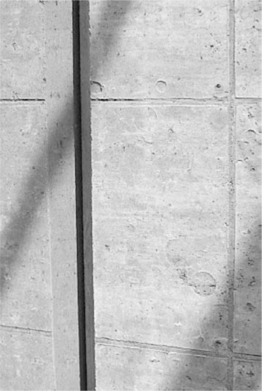
23.9 Chamfered expansion joint detail on an unstabilised rammed earth wall at the Rivergreen Centre, Aykley Heads, Durham, UK. © Rivergreen Developments Plc – Developer/Contractor, photograph by Allan Mushen, 2006
For large openings, stabilised rammed earth can support lintels in one of several ways. For shorter spans these can be formed by designing a reinforcing cage for inclusion in the SRE material, as shown in Fig. 23.10. Due to the significantly lower cement content of stabilised earth compared to concrete, and the presence of clays that can further lower the pH, carbon steel is generally not recommended. It is commonly used in concrete where the cement content is high providing sufficient alkalinity (~13.5 pH) for the steel to form a passivation layer and be protected from corrosion. The problem of reinforcement bar corrosion could be further exacerbated, especially in the presence of chlorides (e.g. on coastal locations exposed to sea spray), if the earth materials have a higher level of liquid/vapour permeability. The example in Fig. 23.10 uses stainless steel reinforcement but glass fibre reinforced polyester (GFRP) could be an equally suitable and high performance alternative.
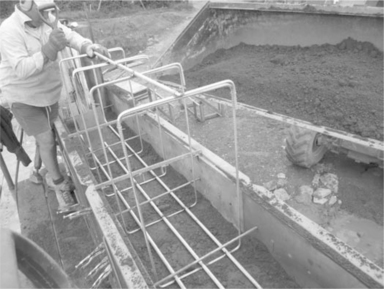
23.10 Stainless steel reinforcement cage used in conjunction with Stabilform™ formwork to produce an integrated SRE lintel, at Straightways Farm, Devon, UK. (© Earth Structures Europe Ltd, 2007)
For cage reinforced integrated lintels, the underside of the material is supported by formwork and telescopic props. The latter remains in place until the SRE has cured for several days to ensure accurate tolerances in its dimensions are maintained, as shown by the example in Fig. 23.11. Note the continuity of the cavity insulation in order to prevent thermal bridging, and the vertical expansion joint to the right of the opening.
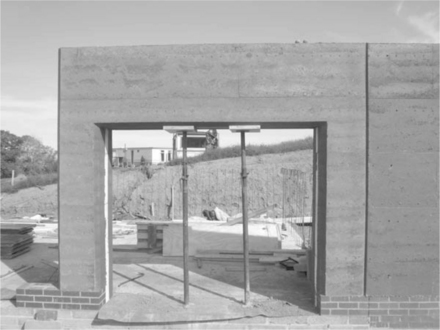
23.11 SRE wall with cage reinforced integrated lintel temporarily supported by telescopic props during curing, at Straightways Farm, Devon, UK. (© Earth Structures Europe Ltd, 2007)
Lintels can also be pre-cast reinforced concrete, timber or equivalent and can be simply supported bearing directly onto the earth walls. The minimum bearing depth is usually 300 mm and the wall can be cast accordingly during placement and ramming. Alternatively, lintels can be steel and fixed into adjacent SRE walls using steel bolts with an epoxy resin bonding agent (see Fig. 23.12). The same technique can be used to support upper floor joints in a multi-storey building but has not yet been applied in Europe. The steel lintel is then supported by telescopic props and formwork during compaction, as for the integrated lintel shown in Fig. 23.11.
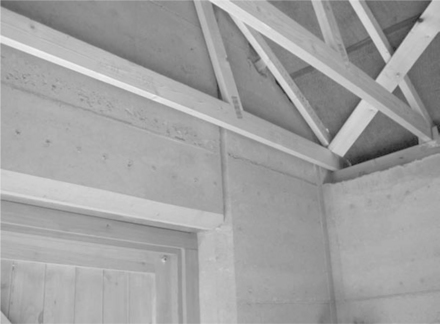
23.12 Steel lintel attached to the adjacent SRE walls using resin-bonded steel bolts on the stables building at The Manor, Ashley, UK. (© M R Hall, 2002)
Rammed earth walls can be built to the same level of accuracy and tolerances as masonry concrete, enabling the use of standard sized window and door frames as well as being able to install effective edge seal detailing. This is shown by the example in Fig. 23.13 where an internal window frame has been installed. Roof connections can take the form of conventional timber wall plates, as shown by the example in Fig. 23.14, which can either be retained by metal wall ties and masonry nails or by resin-bonded bolts fastened vertically through the wall plate into the top of the wall.
23.4 Case studies of modern earth buildings throughout Europe
The number of modern earth buildings (post-1970) throughout Europe is significantly lower than in Australia, North America and India. However, there is quite a diverse portfolio of buildings and a range of innovative techniques and products available, as summarised in the following section.
23.4.1 France
CRATerre-EAG helped to ensure the conception and realisation of two significant modern earth building projects using stabilised compressed earth blocks in the 1980s. These were Villefontaine and the Domaine de la Terre housing complex at I’Isle d’beau (Fig. 23.15) which includes modern houses (Fig. 23.16) and apartments (Fig. 23.17).
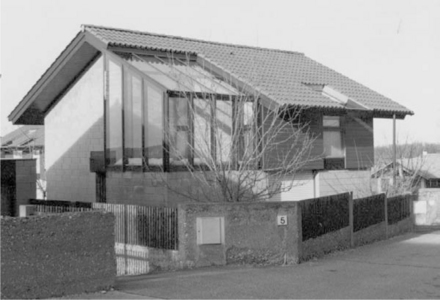
23.16 Stabilised compressed earth block house at Domaine de la Terre, I’Isle d’Abeau. (© Teresa Kelm, 2011)
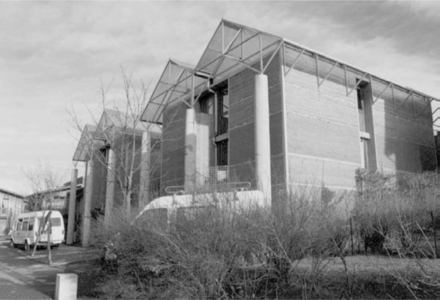
23.17 Stabilised compressed earth block apartment block at Domaine de la Terre, I’Isle d’Abeau. (© Teresa Kelm, 2011)
Nicolas Meunier is a specialist earth building contractor, established in 1981, and member of the ecobati Network. He typically builds between one and two modern rammed earth buildings every year, although the majority of his activity is in the restoration of traditional adobe buildings. Examples of his work include the community building at Valloire Rhône in the Drôme, and also an eco museum, which includes a 60-m-long rammed earth wall at Vinay en Isère in south-eastern France. In 1986, after five years of experience in earth construction, Nicolas Meunier invented a technique of rammed earth prefabrication aimed at adapting the technique to suit the economic context of the modern european construction industry. In 1987, he began experimenting with lifting equipment and earth blocks, and in the following year he built his first prefabricated earth house. The rammed earth blocks are produced in large moulds on the ground before being lifted by crane and placed on a bed of lime mortar. The maximum size of the blocks is 2.2 m long by 1.0 m high with a thickness of 0.5 m. In 1995 he successfully constructed a building comprising three units with a height of 9.4 m and a total wall area of 202 m2 in Montbrison, Loire. Figure 23.18 shows the partially constructed earth walls with pre-fabricated sections being lifted into place. Figure 23.19 shows the present-day completed building with its external render and façade in keeping with the surrounding vernacular. The soil was extracted and delivered to site from Sainte-Agathe-la-Bouteresse, which is approximately 19 km from the site. The building was designed by a successful collaboration between Antoine Morand, Dorat Architect and Nicolas Meunier. Prefabrication is only used for buildings of significant height, since it requires heavier site installation and plant.
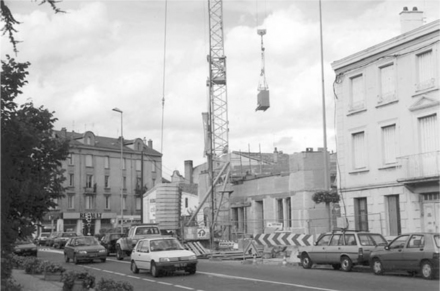
23.18 Pre-fabricated earth walls being craned into position during construction at Montbrison, Loire. (© Nicolas Meunier, 1995)

23.19 Completed 9.4-m-high unstabilised earth wall building at Montbrison, Loire with external render and traditional appearance. (© Nicolas Meunier, 2011)
Meunier always utilises local soils, sourced from within 20 km of the construction site, and generally avoids stabilisation with the exception of 2%wt hydrated lime to assist drying of soils that are excessively wet. For research on thermal and paraseismic behaviour of earth walls, Nicolas Meunier has successfully collaborated with ecole Nationale des Travaux Publics de l’etat (ENTPE), lyon. load-bearing earth walls are typically 500 mm thick. One example is the house at Chasselay (69) north of Lyon, with a living area of 160 m2 and non-insulated 4-m-high rammed earth corner walls designed to absorb, store and release heat energy whilst maintaining sufficient space to allow direct solar gain (see Figs 23.20 and 23.21).
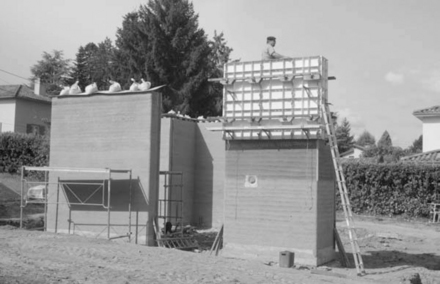
23.20 Use of vertical sliding formwork system during construction of the rammed earth walls at Chasselay. (© Nicolas Meunier, 2011)
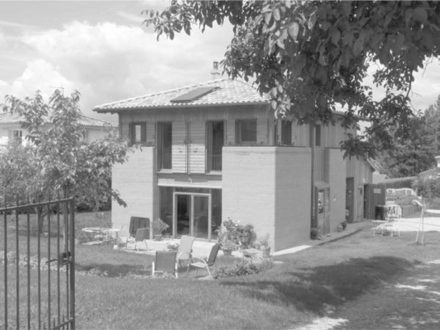
23.21 Completed house at Chasselay with rammed earth corner walls to provide thermal buffering, and lightweight timber frame upper floor construction with increased glazing area to allow direct solar gain. (© Nicolas Meunier, 2011)
AsTerre is The National Association of Earth Building Professionals in France and was founded in 2006. It brings together artisans and entrepreneurs, materials producers, architects, engineers and vocational training bodies. It also hosts representatives from regional organisations and others involved in developing activities within the field of earthen architecture, development of national heritage, contemporary architecture, materials research and technology. AsTerre provide a wealth of information and details of events including conferences, further details of which can be obtained from Section 23.8. In 2009, a school building at ecole de Veyrins-Thuellin, Isère that was designed by Vincent Rigassi, was successfully built using SRE in a region classified as ‘low seismicity’. The building includes classrooms, reading and computer facilities, a canteen, office space and outdoor garden activities.
Le Village in Cavaillon, Vaucluse in southern France is a rammed earth housing development scheme built between 1998 and 2009, designed by Jamal Boudchiche. They are a non-profit organisation whose main aim is to help the unemployed, or those facing other social difficulties, by helping them to find employment whilst providing accommodation in one of the individual houses within the development (25 m2 floor area per house). There are 11 houses in total and they were built by the residents using compressed earth blocks (CEBs) made from locally sourced soil for the load-bearing walls. In a bid to achieve greater financial independence, Le Village began an entrepreneurial venture by producing and selling CEBs to the general public.
The rammed earth leisure centre in Ramatuelle, on the Saint-Tropez peninsula, was designed by ann Guillec and built in 2005. Primarily a children’s facility, the requirement was to have an environmentally friendly building, which offered a high degree of thermal comfort and indoor air quality for its users. The building is made up of wooden boxes corresponding to different spaces.
The large central hall is made from rammed earth and is adjoined by a series of small timber-frame annexes including activity rooms, a library, a dining hall, a kitchen and a sick bay. The building has a green roof and the rammed earth walls are decorated with colour striations for aesthetic appeal. The earth walls were included with the intention of providing good hygrothermal performance, for indoor temperature and humidity buffering, along with suitable acoustic and thermal insulation.
The student halls of residence at the Institut agronomique Méditerranéen de Montpellier (IAMM) consists of three residential buildings and a cafeteria. It houses around 200 students in 82 separate studio flats, eight of which are accessible to those with disabilities. The buildings have green roofs, the ground floor walls are built from Pont du Gard natural stone, whilst the upper floors are built using rammed earth and terracotta bricks, which provides a high level of thermal performance throughout the year. It was designed by Portal-Thomas-Teissier and built between 2007 and 2008. The passageways are generally outside of the building in order to limit the volume of access/ service space requiring heating and air conditioning. The overall operational energy consumption of the building is approximately 60 kWh/m2/year.
23.4.2 Germany
In Europe, Germany possibly has the most successful market in Europe for earth construction products, with an annual turnover of £60 million and a sustained growth of 20% per annum at a time when the rest of the construction industry experienced no growth (Schroeder, 2000). The Berlin Chapel of Reconciliation was constructed in 2000, on the foundations of the previous chapel that had been destroyed, and was designed by the architects Reitermann and Sassenroth. It was the first sacred building to be built from load-bearing rammed earth in Germany, and the altar and bells from the original chapel were preserved and are now housed in the new chapel. The 7.2-m-high internal load-bearing walls are curved and were constructed by lehm Ton erde, led by Martin Rauch, using unstabilised rammed earth. They are 600 mm thick with a clay content of 4%wt, optimum moisture content of 8.1%, linear shrinkage coefficient of 0.15% and compressive strength of 3.2 kN/m2 (Perone, 2008). The building has no heating or air conditioning system and the earth walls are protected from the effects of rain and weathering by an outer wall structure that is clad using vertical wooden slats. As the earth building technique is not well known in Germany, a special case construction permit was needed that required detailed analysis of the material during manufacture and installation as well as careful supervision of the building process. Various trial mixtures were tested for their compressive, tensile and shear strength. A mixture with similar grading characteristics to concrete ballast was selected consisting of clay and stony aggregates to which a small amount of flax fibres were added.
Professor Gernot Minke is an architect and academic based at the University of Kassel. He has been active in the design, construction and research of earth building (including the development of many novel techniques) for over 30 years. His book entitled Earth Construction Handbook (Minke, 2000) summarises many of his activities and small-scale experimental building projects during this time. More recently, the Spandau Youth Centre near Berlin, built in 2005, contains a large internal rammed earth wall that runs for 32.5 m down the middle of the building. The south wall is glazed to maximise solar gain and the main purpose of the high density earth wall is to absorb, store and release heat as well as to regulate ambient relative humidity fluctuations. The Chapel of the Central Clinic in Suhl was completed in 2005, and also contains internal unstabilised rammed earth walls of varying thickness.
CLAYTEC is a manufacturer of earth construction products trading throughout Germany and Europe. They produce clay-based plasters in a variety of different colours including finishing plaster and coarse base coats with fibre reinforcement. They are available as a ready-mixed plaster or as a dry bagged powder that can be mixed with water. In addition, they produce a board product called Lehmbauplatten, which consists of woven fibres and clay binder and offers a rapid solution to interior wall finishing. CLAYTEC also manufacture compressed earth blocks in different dimensions and densities including 700, 1200 and 1500 kg/m3.
The Wangeliner Gardens House, located in Buchberg, is a passive solar design building constructed in 2001 with dense rammed earth internal walls surrounded by a lightweight protective shell of timber frame construction incorporating cellulose-based insulation and with external timber cladding. Clay plasters are used on the walls and ceilings, and rammed earth floors covered with tiles are used in the adjacent glasshouse with a clay stove to provide additional heating. The building also incorporates renewable energy technology including an active solar water heating system and semi-transparent solar panels for the glass house roof covering.
23.4.3 Austria
Kapfinger and Rauch’s book Rammed Earth/Lehm und Architektur/Terra Cruda (Kapfinger and Rauch, 2001) is an excellent case study manual of the structures built by Austria-based rammed earth contractor Martin Rauch, of Lehm Ton Erde Baukunst GmbH. The book provides technical drawings, design details, images and details of Rauch’s significant contribution to modern earth construction including residential, public and commercial buildings in addition to feature walls and structures. Directions to further details of his work and current activities are given in Section 23.8. Well-known examples of his buildings include the Chapel of Reconciliation in Berlin (Germany), as detailed in the previous section. In 2001, a cemetery extension and chapel of rest at Batschuns Voralberg (designed by Marte Architects) was completed. The cube-shaped rammed earth chapel has two earth walls extending out parallel to the sides of the building creating a small courtyard. The soil used for construction was taken directly from the adjacent church grounds. The building foundations are steel reinforced concrete and a concrete bond beam is embedded in the walls of the chapel. The unstabilised earth walls were constructed under the supervision of Martin Rauch and are intentionally over-sized (approximately 450 mm thick) to allow for ‘calculated erosion’, which, theoretically, gives the walls a 100-year life span (Rael, 2009). The interior floor is also rammed earth, which has been stabilised by sealing with a polished wax surface to enhance its resistance to water damage.
Roland Meingast, of Natur und Lehm GmbH, has significant experience of rammed earth construction. Directions for further details about his building projects and research activities are provided in Section 23.8. More recently, Meingast has been involved in the development of LOPAS clay panels, which are a modularised prefabricated building system, as shown in Fig. 23.22.
The maximum panel dimensions are 10 3 m and they are assembled in a way that enables vapour diffusion through both sides, which allows drying transport processes within the multi-layer assembly and moisture equilibration for humidity buffering applications. The LOPAS system was successfully deployed within the clay passive office building ‘Lehm – Passiv Bürohaus’ in Tattendorf; a prototype that was built in 2004 as part of the ‘Haus der Zukunft’ demonstration programme organised by the Austrian Federal Ministry for Transport, Innovation and Technology (BMVIT; Bundesministerium für Verkehr, Innovation und Technologie). The biofibre clay plasters, used as part of these panels, were developed and patented by Meingast as part of the EU-funded ‘Plaster+’ project that ran from 2006 to 2008 (Meingast, 2005).
The clay-plaster layers (layers 1 and 2) have multiple functions including humidity buffering and thermal storage (without chemical stabilisation, as specified by the Dachverband Lehm), whilst providing space for installation of electric conduits or wall heating/cooling pipe systems, or firewall. The U-value of the walls is 0.1 W/m2 K, and Lopas AG (Austria) produce these prefabricated passive house panels at the wood industry plant of their stockholder Holzbau Longin GmbH.
Table 23.1
The composition of an exterior LOPAS panel (from inside to outside)
| 1 | 10 mm | Biofaserlehm™ fine clay render (reinforced with cattail – fibres) Note: applied on building site after mounting of the panel |
| 2 | 35 mm | Biofaserlehm™ base coat clay plaster (reinforced with hemp fibres) |
| 3 | – | Clay-fleece (incorporated within the base layer) |
| 4 | 22 mm | Wooden boards or OSB |
| 5 | 400 mm | Insulation from chipped straw/ wall posts |
| 6 | 22 mm | Wooden boards or OSB |
| 7 | 5 mm | Clay-fleece, clay plastered |
| 8 | – | External cladding (selectable): timber cladding or exterior render |
23.4.4 Switzerland
The Sihlholzli Sports Facility in Zurich was designed by Roger Boltshauser and includes two small storage facilities and a chronometry tower to time the track events. Built in 2002, the storage buildings were constructed from 450-mm-thick unstabilised rammed earth, with a 9–12-mm-thick layer of cement mortar for every 450 mm of height to help prevent surface erosion. The chronometry tower is two stories high and constructed from 600-mm-thick unstabilised rammed earth. The foundations for slab and first floor are constructed from concrete.
23.4.5 United Kingdom
At the Eden Project in Cornwall, the walls of the visitors’ centre (see Fig. 23.1) were built by In Situ Rammed Earth Ltd in 1999 using unstabilised soil that had been excavated on site. The soil was mixed then placed using skidsteer loaders and compacted to form 40 panels, each 2.5 m high and with a mass of approximately 10 tonnes. In order to protect the wall surfaces from weathering and erosion they were painted with a chemical sealant comprising sodium silicate. Mount Pleasant Ecological Park at Porthtowan, Cornwall, provides a workspace for local businesses, as well as training and education in traditional and sustainable skills for schools, colleges, universities and the general public. The main building was constructed in 2003 from unstabilised rammed earth by Tim Stirrup, with advice from Rowland Keable at In Situ Rammed Earth Ltd. An ‘off grid’ dormitory and meeting space at Bradwell on Sea, Essex was built in 2010 for the Othona community by volunteers. They had a minimal budget and took technical advice on the rammed earth construction from Ram Cast CIC. The unstabilised rammed earth walls are built on a raised plinth using traditional formwork comprising scaffold planks and tubes with tourniquet bindings. The College Lake Visitor Centre at Tring, built for the Berks, Bucks and Oxon Wildlife Trust in 2009, was constructed using unstabilised rammed chalk with technical advice from Ram Cast CIC.
Pines Calyx is an eco conference centre located at St Margaret’s Bay near Dover in Kent, UK (see Fig. 23.23). It was designed by Conker Conservation and built by In Situ Rammed Earth Ltd in 2005. It also acts as the centre point of an emergent Centre for Sustainable Living and a hub for sustainable enterprise in Kent, with activities and projects centred on the emerging low carbon economy. The main centre comprises two circular buildings at separate levels and constructed from unstabilised rammed chalk. Following the success of this building, Conker Conservation went on to design the Ivylands classroom based at Plumpton College for Sustainable Food and Farming in Battle, East Sussex. It was constructed in 2007 with technical advice from Ram Cast CIC. It was built using unstabilised rammed earth internal walls protected from the weather by an external timber façade. Rammed chalk walls were also used in the construction of the Sheepdrove Eco Conference Centre in Berkshire.
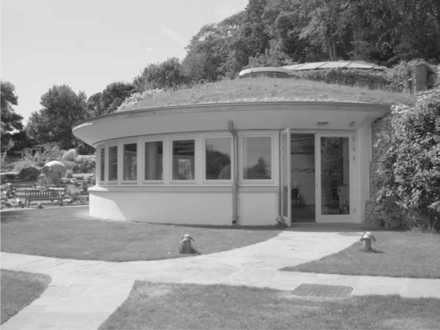
23.23 Unstabilised rammed chalk walls at the Pines Calyx Conference Centre, St Margaret’s Bay, Kent, UK. (© A Hall, 2008)
The Rivergreen Centre at Aykley Heads near Durham (see Fig. 23.24) was designed by Jane Darbyshire and David Kendall (JDDK) architects and built by Rivergreen Developments in 2005. It is a two-storey office building that achieved a BREEAM ‘excellent’ rating. The structure uses a post-tensioned concrete slab at first floor level, supported on cast in situ, reinforced concrete columns that are full height from ground floor to first floor. The bow string truss roof and supporting columns are made from douglas fir timber. The central double-height atrium houses a non-structural unstabilised rammed earth wall along the northern side. The height of the space allows solar irradiation to heat the earth wall, which is intended to act as a temperature and humidity buffer. The wall is 6 m tall and 600 mm thick, with 80% of the soil used in its construction being fine sand excavated from the site during construction of the building’s basement. The sand was mixed with gravel and clay extracted from local quarries. JDDK Architects commissioned the Department of Architecture and Civil Engineering, University of Bath, to develop the optimum soil blend and perform mechanical testing of rammed earth test specimens. The wall itself was constructed in six separate vertical sections with expansion joints in between to limit the effects of linear shrinkage. Technical advice on rammed earth construction was provided by Simmonds Mills Architects and also In Situ Rammed Earth Ltd.

23.24 Atrium at the Rivergreen Centre housing the non-load bearing, 6-m-high unstabilised rammed earth wall. © Rivergreen Developments Plc – Developer/Contractor, photo by Allan Mushen, 2006
In 2003, a stabilised rammed earth pavilion was constructed at the Brimington bowling club in Derbyshire, to be used as a centre for the local residents (see Fig. 23.25). The project was initiated and led by Dr Matthew Hall in close collaboration with Chesterfield Borough Council. Limitations were imposed on the entire project by the addition of a challenge to construct the earth wall and roof structures within a continuous 24-hour period. The challenge, which was subsequently met and completed in just 21.5 hours, was proposed by a television company that had been commissioned by the BBC to produce a programme about the project called ‘Home wasn’t built in a day’. The resultant building is a medium-sized bungalow approximately 12 m long by 5 m wide. The purpose of the challenge was to illustrate to the public that alternative, eco-friendly construction techniques can provide a rapid and effective solution to the national shortage of housing in the UK. This project also served to demonstrate how full compliance with the UK Building Regulations could be demonstrated using SRE for external load-bearing walls. Further details of this project can be found in the article ‘Stabilised Rammed Earth (SRE) and the Building Regulations (2000): Part A – Structural Stability’ (Hall et al., 2004).
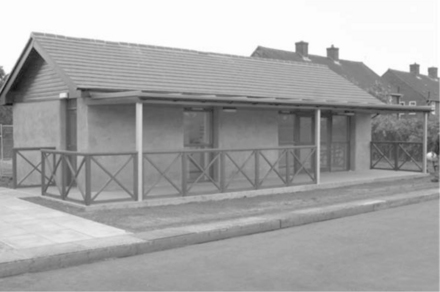
23.25 Brimington bowls pavilion, built in just 21.5 hours including the 17.5 m3 of load-bearing stabilised rammed earth walls and the timber truss roof structure plus roof covering. (© M R Hall, 2003)
In 2007 Straightway Farmhouse was constructed at Honiton in Devon (see Fig. 23.26). The architect was Roderick James Architects, the consulting engineers were Mark Lovell Design Engineers and the contractor was Earth Structures (Europe) Ltd. The rear external walls of the accommodation were made of solid cavity SRE, 530 mm thick including 100 mm EPS solid cavity insulation at the centre, which achieved a U-value of 0.19 W/m2 K. This amounted to 89 m2 of walling with the maximum height being 5.2 m. The building was constructed in three wings joined together at the centre of a three-pointed star. The rammed earth formed the back wall of each wing, with green oak frames and insulated panels forming the other walls of the rooms.
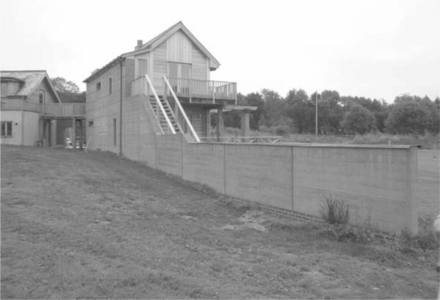
23.26 Straightways Farm House constructed using cavity insulated SRE in Honiton, Devon. (© Earth Structures Europe Ltd, 2007)
The internal walls and garden walls were of solid SRE 300 mm thick. Lintels over windows and doorways were made by including reinforcing steel within the rammed earth. The largest openings were for two garage doors, each being 2.5 m wide. A specially designed cage of stainless reinforcing steel was included within the insulated rammed earth walls to span these openings. The soil used for this building was a dark red naturally occurring mix of gravel, sand, silt and a small proportion of clay. It was used in the as-raised condition and extracted from natural banks just a few miles from the building site, previously offered to local firms as a stable road base. Test cores were made of this material, which achieved a compressive strength of between 5.1 and 7.7 N/mm2. SRE was also selected for the central wall of the proposed Construction Industry Training College in the Thames gateway, but unfortunately the project was cancelled when Government funds for tertiary colleges were cut.
Earth construction materials are often used for artistic (non-building) purposes within Europe, as exemplified by the temporary display of an electricity pylon in Birmingham city centre, UK. Pre-cast SRE panels were constructed and used to represent a cross-section through the ground beneath the pylon complete with wheat to represent field crops growing on the surface of the soil.
The Birmingham Climate Change Festival was planned by Commission for Architecture and the Built Environment (CABE) and was erected in front of the Town Hall, Victoria Square, Birmingham from 2nd–7th June 2008. The Festival was intended to inspire the public to think about the creation and transmission of energy. The display was designed by Block Architecture and consisted of a 35-m-high steel electricity pylon that had been nickel plated and polished, standing in a square field of wheat that was 12 12 m. The field was raised 1.2 m above the pavement with exposed ‘earth’ sides consisting of 24 panels of pre-fabricated SRE. Each panel measured 1.2 2 m and weighed approximately one tonne. The SRE panels were made in Ashley, Market Harborough and transported on a low loader to Birmingham a day before the festival started and erected around the base of the pylon with the aid of a telehandler (see Fig. 23.27).
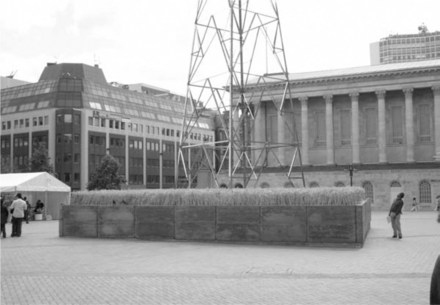
23.28 Model electricity pylon in Birmingham city centre with pre-cast SRE wall panels at the base (© Earth Structures Europe Ltd, 2008).
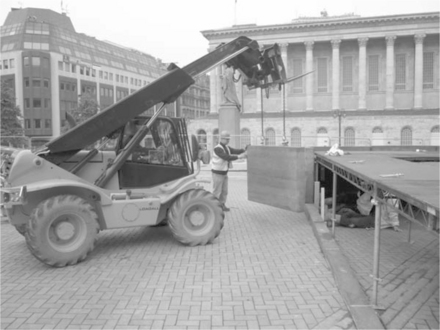
23.27 Pre-cast SRE wall sections with internal steel reinforcement being delivered and offloaded from a flatbed truck in Birmingham city centre. (© Earth Structures Europe Ltd, 2008)
The Autonomous Environmental Information Centre (AtEIC) at the Centre for Alternative Technology (CAT) in Machynlleth, Wales, was designed by architect Pat Borer with advice from Simmonds Mills Architects who worked as the specialist design/construction team on the rammed earth components. The building atrium includes a large unstabilised rammed earth wall covered by transparent plastic sheets to prevent accidental damage from the large number of visitors. More recently at CAT, Pat Borer designed the WISE education centre, which includes rammed earth walls and also uses a series of other materials with low embodied energy including a glulam timber frame, hemcrete walls, lime render, natural slate, cork, home-grown timber flooring, and natural paints and stains. The building is intended to have high levels of fabric insulation and airtightness combined with heat recovery in some spaces. The circular 200-seat rammed earth lecture theatre is at the centre of the building. The 7.2-m-high loadbearing walls are 500 mm thick, curved and built from unstabilised rammed earth (see Fig. 23.29). The soil was blended to a specified mix using quarry waste taken from nearby Llynclys Quarry. The lower 1.8 m of the walls had a colourless silicate-based sealant (supplied by Keim) applied to prevent dusting of occupants’ clothing. Pneumatic tampers were used for the compaction along with a proprietary shuttering system. Figure 23.30 shows the interior of the lecture theatre with the large exposed rammed earth walls providing passive temperature and humidity buffering to the occupied space (often referred to as ‘mobilised mass’). This exemplifies one of the key advantages of earth materials in that when a building is periodically occupied, the increase in internal loads can be significant when a large group of people enter the building. The thermal and hygric mass of the earth walls helps to counter any reductions in thermal comfort by buffering the variations in dry bulb air temperature and relative humidity through absorption/desorption of heat and water vapour.
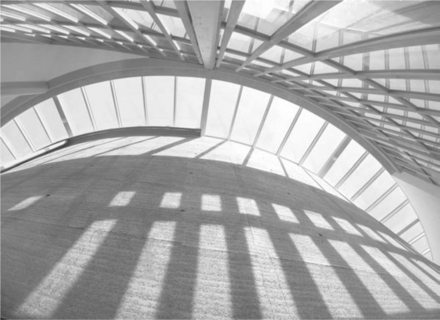
23.29 Load-bearing, curved unstabilised rammed earth walls forming the structure of the WISE Lecture Theatre, Centre for Alternative Technology. (CAT), Wales (© Pat Borer, 2011)
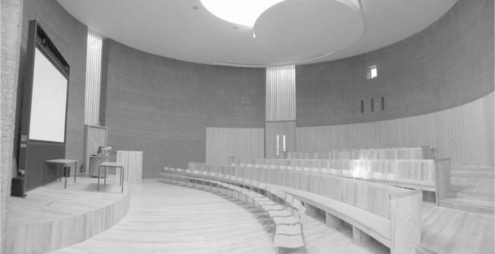
23.30 Interior of the WISE Lecture Theatre, Centre for Alternative Technology. (CAT), Wales (© Pat Borer, 2011)
In 2002, Arc Architects based in Fife, Scotland, led a project to develop unfired clay bricks and mortar for the Errol Brick Company Ltd. This was followed by a three-year UK Government funded (by the former Department for Trade and Industry, DTI) ‘Partners in Innovation’ project to assess the commercial feasibility of low-cost unfired clay bricks, clay mortars and clay renders for modern construction. The final report is available from Arc Architects (see Section 23.8) and includes the findings from a detailed case study that included design, procurement, construction, performance monitoring (thermal, acoustic and hygric) and post-occupancy evaluation of an unfired clay brick house. The benefits of unfired clay in buffering indoor relative humidity fluctuations were clearly demonstrated: external air relative humidity fluctuated considerably between 24.9 and 96.1% but the mean internal value was around 45% and only fluctuated beyond the thermal comfort range (40-60%) for relatively short intervals (Morton et al., 2005).
23.4.6 Spain
Although Spain has a vast history of traditional adobe building and extensive examples of heritage structures, modern examples are starting to become more frequent. Recent examples include Amayuelas de Abajo, which is a group of ten detached houses built in 2001 in Palencia, northern Spain. They were designed for a group of local ecologists by the architects María Jesús González Díaz, Jorge Silva Uribarri and Farncisco Valbuena García. The houses were intentionally designed to blend into the surrounding landscape and incorporate renewable energy technologies such as solar thermal and solar photovoltaic (PV). The walls are constructed using traditional unstabilised adobe bricks, both to provide indoor air temperature buffering (thermal mass effect) and to re-introduce a traditional method of construction to the area. The lack of skilled adobe craftsmen, no industrial-scale production and no specifications for adobe in current building standards presented problems during construction, but these were overcome. More recently, a public swimming bath building in Toro was designed by Vier Architects and built in 2010. The use of unstabilised load-bearing rammed earth plays a crucial role in the construction and intended appearance of the building. The solid walls have a U-value of 1.26 W/m2 K and the acoustic damping of aerial noise has been stated as 69.21 dBA.
23.4.7 Portugal
Dr Arch Mariana Correia has been involved in research, mainly in the conservation of heritage earth construction but also some modern earth construction and European Union-funded projects. In terms of recent examples of modern earth construction, a monitoring centre at a water treatment station in Évora, designed by João Alberto Correia, was built in 2010. It has load-bearing rammed earth exterior walls designed to provide passive temperature buffering in the hot and dry region of Alentejo. A silicone-based surface treatment was sprayed onto the external earth wall to provide a water-resistant coating that maintains vapour permeability.
23.4.8 Poland
Amongst the range of eco buildings being constructed in Eastern Europe is an experimental house in the Ecological Park of the city of Pasłęk. It was designed by Teresa Kelm, Jerzy Gorski and Marek Kollataj from the Politechnika Warszawska (Technical University of Warsaw) and was built in 2008. Laboratory tests and investigations were conducted to determine the physical and mechanical properties of the SRE material that was used for construction. The walls were constructed using panelled timber formwork (see Fig. 23.31) to create a textured outer wall surface whilst maintaining accurate dimensions required for window and door openings. The load-bearing walls were stabilised with 8%wt Portland cement and compacted using pneumatic tamping equipment and include a large curved section, as shown in Fig. 23.32.
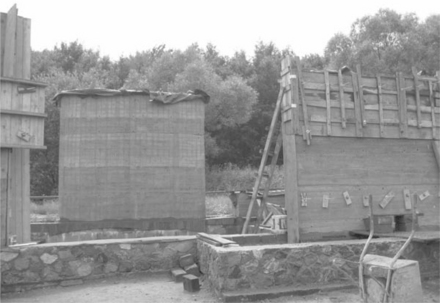
23.31 Panelled timber rammed earth formwork used at the Pastek experimental research house. (© Teresa Kelm, 2008)
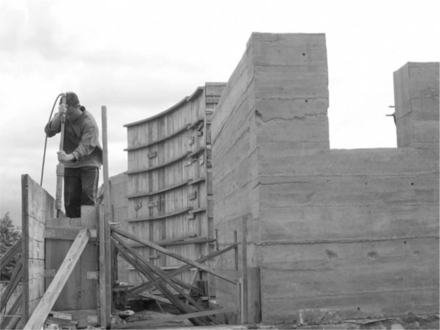
23.32 Pneumatic compaction of rammed earth walls, including a large curved section, at the Pastek experimental research house. (© Teresa Kelm, 2008)
The purpose of the project was partly demonstration but also to make observations and conduct research during the design and construction process. The building is energy efficient and has been designed for a final wall U-value of 0.33 W/m2 K, and utilises passive solar design by harnessing the direct irradiation gains entering via a greenhouse space on the south side of the building. The next phase will see the interior of the building completed including the installation of mechanical services and fabric insulation. The planned research aims to monitor indoor air temperature and humidity fluctuations to assess the performance of the earth walls. The completed building is shown in Fig. 23.33 and was one of the winners of the ‘Outstanding Earthen Architecture in Europe’ award 2011 by an international jury as part of the EU-funded ‘Terra Incognita’ project, in recognition of its innovative design and construction methodologies.
23.5 Future trends
People often ask why modern earth is not as widely adopted in Europe as it is elsewhere in the world. Speed, cost effectiveness, and high levels of material and structural performance are being demonstrated in North America and Australia, which is now starting to spread into Asia. These skills are transferrable and can be imported across the world. Regulations are in place in some European countries and not others, but this seems to make little difference to the motivation for large numbers of new modern earth buildings. Perhaps the irony exists in this being perceived as a non-conventional material, and yet by definition it is the most widely used construction material in the world; in the true sense it is the most conventional and with the longest proven track record.
Unlike North America, India and Australia where modern earth building is comparatively prolific, modern European examples have favoured a larger proportion of unstabilised or traditional earth building techniques including rammed earth, adobe, compressed earth block and unfired clay brick. However, most if not all of these examples have still used cement in other ways chiefly in concrete foundations or concrete bond beams, whilst some have used traditional lime binders as a Portland cement substitute. In northern European countries such as the UK, Austria and Germany, unstabilised earth walls are generally deemed to be suitable for internal wall applications and, although they can be load-bearing, must be protected from exposure to the weather (e.g. with wooden cladding) unless erosion of the wall surface is desired. The use of unfired clay materials, including renders, appears to be quite well established in Germany and perhaps currently represents the largest market for modern earth building materials in Europe.
In Europe, there are many individual examples of modern earth construction being used for experimental houses, commercial buildings, public centres, and for iconic centrepieces in larger buildings. However, for modern earth construction to be more widely accepted, utilised and commercially viable it may be prudent to see what lessons can be learned from other regions of the world where it has been much more prolific and has become a recognised member of the construction industry, e.g. North America, India and Australia. One of the areas that clearly separates European modern earth building from these regions is the move towards a higher level of mix design specification, standardised quality control and levels of physical/mechanical performance that are compatible with those of alternative techniques such as concrete block and/or fired clay brick masonry, timber frame, and pre-cast or in situ cast concrete including established steel reinforcement techniques. Also, in North America and Australia several supporting industries have emerged and developed specific products to compliment stabilised earth materials including proprietary additives and vapour-permeable hydrophobic admixtures to significantly enhance material performance and longevity. Significant experience already exists in these other regions of the world for mix design to control mechanical properties, durability and appearance, as well as building in very cold and/or wet climates (e.g. Canada), which would have significant benefit for use in northern Europe including Scandinavia.
23.6 Acknowledgements
The authors would like to express their gratitude to the following individuals whose helpful discussion and generosity contributed to the production of this chapter: Paul Jaquin, Hubert Guillaud, Nancy Happe, Maddalena Achenza, Mariana Correia, Jean-Claude Morel, Roland Meingast, Nicolas Meunier, Claire Moreau, Pat Borer, Teresa Kelm, Peter Candler, Dirk Bouwens, Adele Mills, Kevin McCabe, Roger Hendry, Anthony Goode, Rubén Lagunas, Mariette Montanier and Allan Mushen.
23.7 Sources of further information
Terra Incognita: Discovering and Preserving European Earth Architecture (2 volumes). Published in 2006 by Culture Lab Editions and Editora Argumentum, GHHI. Editors: CRAterre-ENSAG, École d’Avignon, ESG/Escola Superior Gallaecia, Universidad Politécnica de Valencia and University of Florence.
Terra Britannica: A Celebration of Earthen Structures in Great Britain and Ireland, by Gourley B and Hurd J (eds), published in 2002 by Maney Publishing.
Terra 2000: 8th International Conference on the Study and Conservation of Earthen Architecture, Torquay, Devon, UK, May 2000, published by James & James (Science Publishing) Ltd., London.
MEDITERRA 2009: 1st Mediterranean Conference on Earth Architecture, published in 2009 by EDICOM, Universitat di Cagliari, ESG/Escola Superior Gallaecia, CRATerre-ENSAG.
Rammed Earth: Design and Construction Guidelines, by Walker P, Keable R, Martin J and Maniatidis V, published in 2005 by BRE Bookshop, Watford.
Earth Building: Methods and Materials, Repair and Conservation, by Keefe L, published in 2005 by Taylor and Francis, London
Rammed Earth/Lehm und Architektur/Terra Cruda, by Kapfinger O and Rauch M, published in 2001 by Birkhauser
Earth Building, by Jaquin P and Augarde P, published in 2011 by HIS – BRE Press
Houses and Cities Built with Earth: Conservation, Significance and Urban Quality, published in 2006 by Editora Argumentum with the support of the ‘Culture 2000’ programme of the European
Union, Lisbon, by Achenza M, Correia M, Cadimu M and Serra A (eds). Earth Construction Handbook: The Building Material Earth in Modern Architecture – Advances in Architecture vol 10, by Minke G, Published in 2000 by WIT Press
Terra Europae, published in 2011 by Edizioni ETS and Culture Lab Editions, Italy. Scientific coordination: University of Florence, École d’Avignon, ESG/Escola Superior Gallaecia, Universidad Politécnica de Valencia, CAUE.
Earth Architecture in Portugal, published in 2005 by Argumentum, with the support of ESG/Escola Superior Gallaecia; Lisbon, by Fernandes M and Correia M (eds).
European earth building contractors and specialist advisers
The following is a selection of relevant and active bodies, and not an exhaustive list:
Association of Earth Building Professionals, 67 Rue Pierre Tal Coat 27000 Evreux, website: www.asterre.org
CRAterre-ENSAG (l’Ecole Nationale Supérieure d’Architecture de Grenoble), 60 avenue de Constantine – BP 2636 38036 Grenoble, Cedex 2, France (contact: Prof Hubert Guillaud), website: http://craterre.org/
Le Pisé (contact: Nicolas Meunier), France, website: www.construction-pise.fr
Lehm Ton Erde Baukunst GmbH (contact: Martin Rauch), Austria, website: www.lehmtonerde.at
Historic Rammed Earth (contact: Dr Paul Jaquin), UK, website: www.historicrammedearth.com
Lehm Und Natur GmbH (contact: Roland Meingast), Austria, website: www.lehm.at
Earth Structures (Europe) Ltd (contact: Bill Swaney), UK, website: www.earthstructures.co.uk
Ram Cast CIC (contact: Rowland Keable), UK,website: www.rammed-earth.info/
Arc Chartered Architects (contact: Tom Morton) – specialising in ecological architecture, research and conservation – 31a Bonnygate, Cupar, Fife KY15 4BU, Scotland, UK website: www.arc-architects.com/
Little and Davie Construction (contact: Becky Little), Stone, Earth and Lime Builders, Ash Cottage, Monimail, Cupar, Fife KY15 7RJ, UK website: www.littleanddavie.co.uk
AsTerre (l’Association Nationale des Professionnels de la Terre Crue) Clayworks Ltd (contact: Adam Weismann), Cott Farm, Constantine, Cornwall TR11 5RP, UK, website: www.clay-works.com
23.8 References
Achenza, M., Correia, M., Cadimu, M., Serra, A. Houses and Cities Built with Earth: Conservation, Significance and Urban Quality. EU, Brussels: Editora Argumentum, Culture 2000 Programme; 2006.
BRE, Green Guide to Specification. Building Research Establishment, 2008. www.bre.co.uk/greenguide [available at:].
Easton, D. The Rammed Earth House. White River Junction, Vt: Chelsea Green Publishing Company; 1996.
Gourley, B., Hurd, J. Terra Britannica: A Celebration of Earthen Structures in Great Britain and Ireland. Leeds: Maney Publishing; 2002.
Hall, M., Damms, P., Djerbib, Y. Stabilised rammed earth (SRE) and the building regulations (2000): Part A – structural stability. Building Engineer. 2004; 79(6):18–21.
Kapfinger, O., Rauch, M. Rammed Earth/Lehn und Architecture/Terra Cruda. Basel: Birkhäuser; 2001.
Keefe, L. Earth Building: Methods, Materials Repair and Conservation. Abingdon: Taylor and Francis; 2005.
Meingast, R., Lehm-Passiv Bürohaus Tattendorf, Berichte aus Energie-und Umweltforschung 29/2005. 2005 www.HAUSderzukunft.at [Hrsg.: BMVIT Wien 2005, available at:].
Minke, G. Earth Construction Handbook: The Building Material Earth Architecture – Advances in Architecture Vol 10. Southampton: WIT Press; 2000.
Morton, T., Stevenson, F., Taylor, B., Smith, N.C., Low cost earth brick construction 2 Kirk Park, Dalguise: monitoring and evaluation. 2005 www.arc-architects.com/downloads/Low-Cost-Earth-Masonry-Monitoring-Evaluation-Report-2005.pdf [final report – DTi Partners in Innovation project, available at:].
Perone, C. Prefabricated earth constructions in the UK and Europe. The Structural Engineer. 2008; 86:32–39.
Rael, R. Earth Architecture. New York: Princeton Architectural Press; 2009.
Schroeder, H., Proceedings of Lehm 2000: Beitrage Zur 3. Internationalen Fachtagung Lehmbau Des Dachverbands Lehm E.V., 17th – 19th November, Berlin, 2000.
Stokes, A., Cob dwellings: compliance with the Building Regulations 2000 (as amended) – the 2008 Devon model. guidance document – Devon Earth Building Association, 2008. www.devonearthbuilding.com/leaflets/building_regs_pamphlet_0 8.pdf [available at:].
Wooley, T., Natural materials, “zero emissions” and sustainable construction. Proceedings of Terra 2000: 8th International Conference on the Study and Conservation of Earthen Architecture,. James & James (Science Publishing) Ltd, London, 2000.

